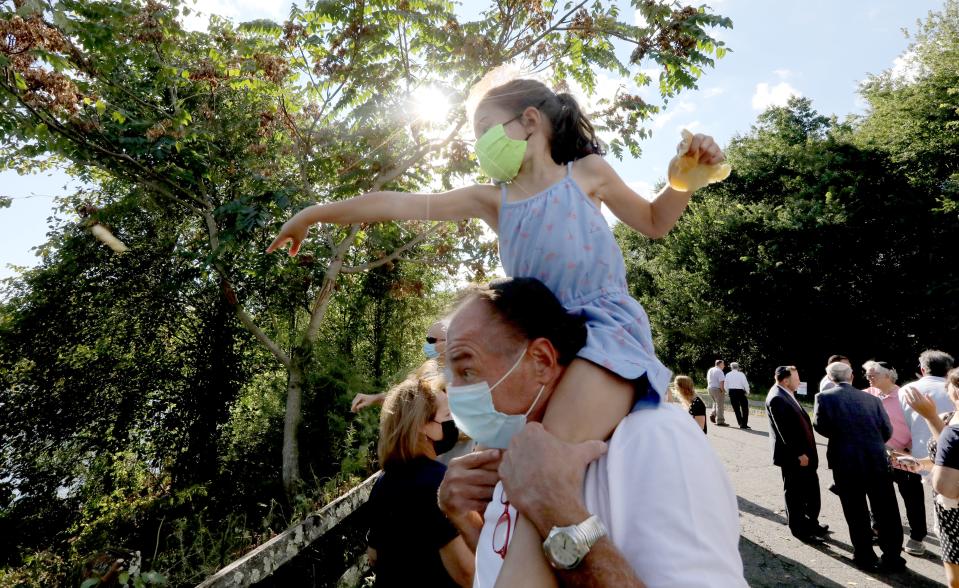COVID brought new levels of meaning to Jewish high holidays. Here's how
More than any other time of the year, the High Holidays of Rosh Hashanah and Yom Kippur are when Jewish people gather in synagogues. Since the days of the ancient Temple in Jerusalem through 2019, these holidays marked a celebration of our faith and traditions, a time to join with family and friends and pray for the year ahead. However, 2020 and 2021 were a sharp departure from the norm, as the pandemic threw a wrench into our millenia-old holiday traditions. Many houses of worship were closed or saw a significant reduction in in-person participation as people remained socially distanced and quarantined in their homes.
At my congregation in Mamaroneck, New York, Rosh Hashanah 2020 saw a modest assembly of congregants gather to pray outdoors, safely maintaining distance. Others joined us at a local park for tashlich services, where we symbolically casted away our sins, and to hear the shofar’s blasts. Some took home Chabad’s “Rosh Hashanah in-a-box” and celebrated within the safety of their homes. All in all, it was a far cry from the year before, when hundreds gathered with Chabad for inspirational services, communal prayer and delicious holiday meals.
However, amidst these outdoor, distanced and abbreviated High Holidays, something remarkable happened: we discovered a sense of inner connection and meaning.

The isolation, the riverside services, and the double-wrapped to-go containers of challah, brisket and Rosh Hashanah tzimmes, allowed us to uncover a newfound sense of meaning; the type we would do well to carry with us as we return to business as usual this year.
Stripped away from our regular routine, the pandemic’s absence of usual synagogue services inspired us to connect with ourselves. We discovered that the holidays had the meaning that each of us put into them — and I have heard from so many that their prayers in solitude gave them new appreciation for the words they were saying, for their connection with G-d and with their own selves. The pandemic’s surge of personal connection to the divine has been especially felt by our nation’s young people.
This year, much like the last, we are able to once again gather as a community, to listen to the cantor’s soulful renditions of the liturgy and the rabbi’s (hopefully) interesting and inspiring sermons. But let's not lose sight of that one-on-one connection with G-d, the focus on the words we utter, and the sense of ownership of our prayers that we picked up in the pandemic. We are not mere spectators; we are active participants. COVID served as a poignant reminder of this truth.
In 2020, we gathered in parks and street corners to hear the shofar because that was the only safe way to do that; it was the way to make shofar accessible during a pandemic. This year, although we’ve returned to the synagogue, we need to to ensure that holiday observances remain accessible to those who can’t join us in person. Of course, an abbreviated, outdoor service is no substitute for the real deal, but bringing the shofar to parks, street corners, homes, prisons and hospitals ensures that people who might otherwise not have the opportunity to observe these Rosh Hashanah mitzvotare able to do so. COVID served as a powerful reminder of this inclusivity.
As we sit down to Rosh Hashanah dinner with family and friends, let’s remember those days of Rosh Hashanah-to-go packages and recognize that while we may be able to celebrate comfortably, there are many who will not easily be able to do so, whether it is for financial, health-related or other reasons. As the Torah enjoins us over and over, when we celebrate we should always bear in mind the needs of society’s most vulnerable members, and share what we have with those in need. COVID taught us this lesson well.
So, as we prepare for a "normal" High Holidays where Chabad welcomes everyone in the community, regardless of membership or affiliation, and expects larger crowds than before COVID, let's pledge that our holiday observances will never revert to their pre-pandemic state. Instead, let's ensure they become better, more meaningful, and more inclusive than ever before.
Rabbi Mendel Silberstein directs Chabad of Larchmont and Mamaroneck with his wife, Chana. For more information, visit Chabad101.com
This article originally appeared on NorthJersey.com: Jewish high holidays 2023: COVID amplifies sacred days

